EBUS614: Analysis of Budgeting and Scheduling in Project Management
VerifiedAdded on 2020/11/30
|44
|2950
|305
Report
AI Summary
This report provides a comprehensive overview of budgeting and scheduling within project management, drawing from a lecture on the topic. It delves into the core concepts of budgeting, including budget estimation techniques like top-down and bottom-up approaches, work element costing, and the distinction between category and project budgeting. The report then transitions into scheduling, explaining techniques and terminology, such as network diagrams (Activity on Node), expected time calculations, critical path analysis, and the concept of slack. The content covers essential aspects of project planning and control, offering practical insights into resource allocation, time management, and the effective use of scheduling tools to ensure project success. The report also includes quizzes to test the understanding of the concepts.
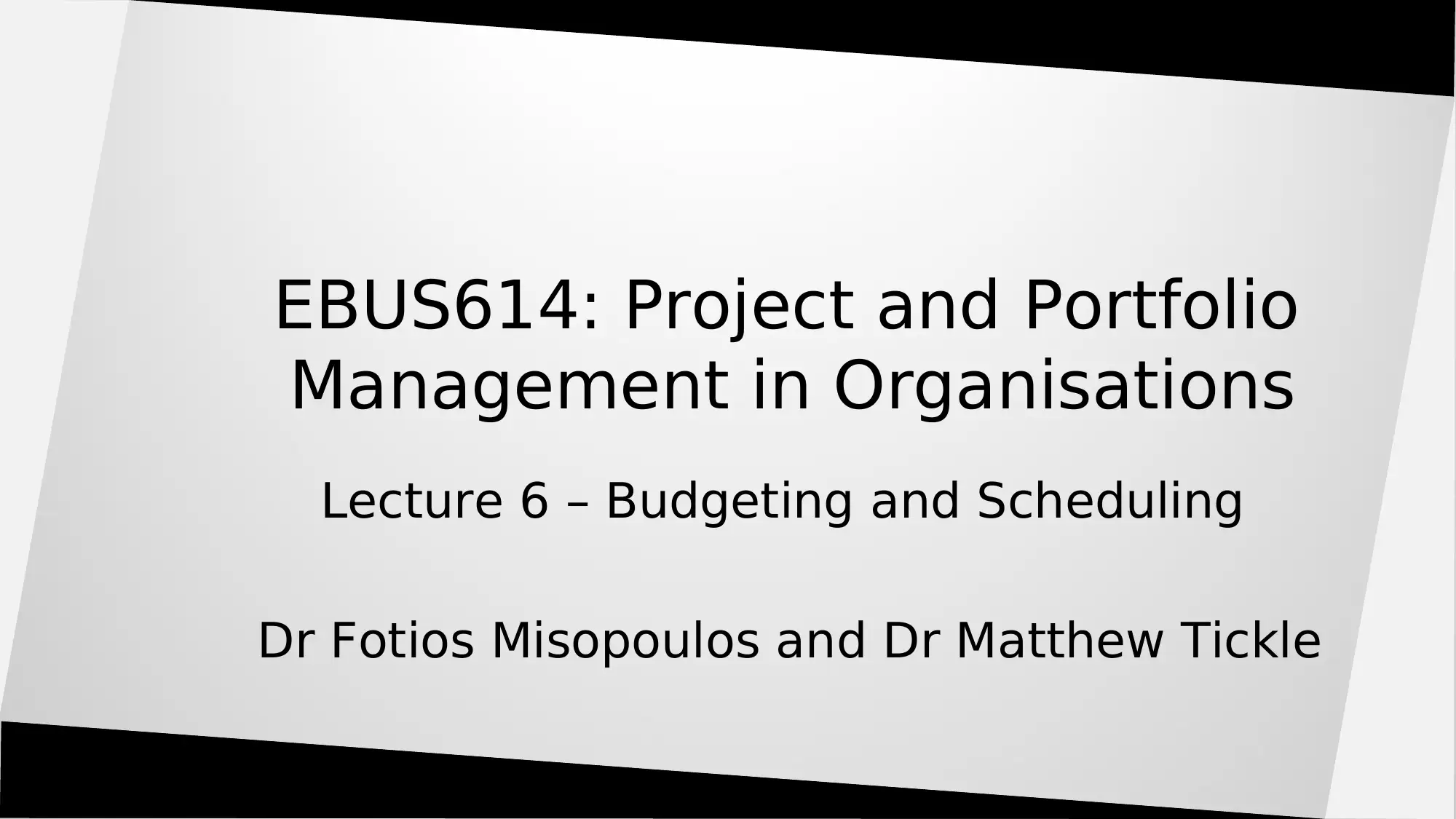
EBUS614: Project and Portfolio
Management in Organisations
Lecture 6 – Budgeting and Scheduling
Dr Fotios Misopoulos and Dr Matthew Tickle
Management in Organisations
Lecture 6 – Budgeting and Scheduling
Dr Fotios Misopoulos and Dr Matthew Tickle
Paraphrase This Document
Need a fresh take? Get an instant paraphrase of this document with our AI Paraphraser
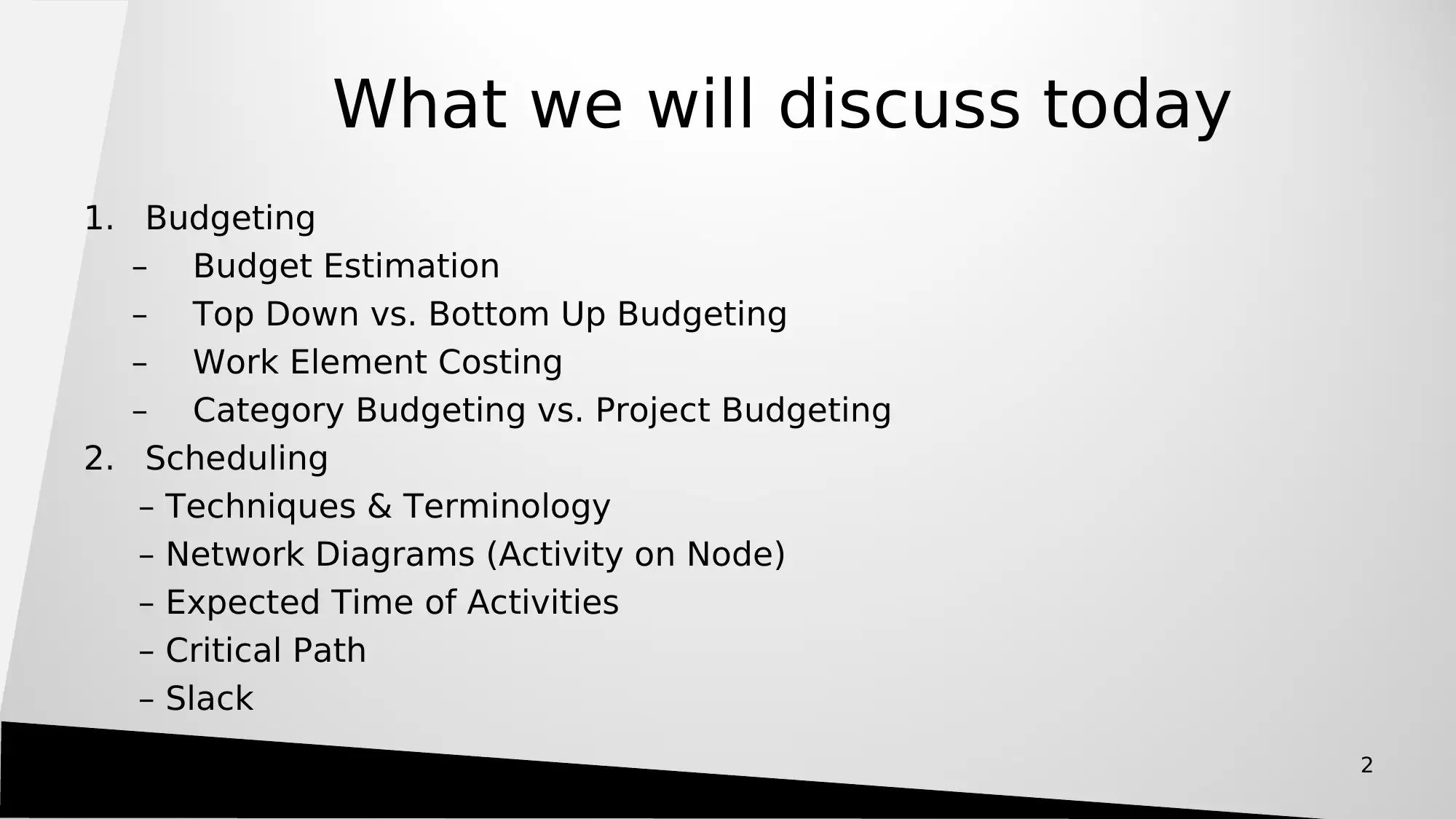
What we will discuss today
1. Budgeting
– Budget Estimation
– Top Down vs. Bottom Up Budgeting
– Work Element Costing
– Category Budgeting vs. Project Budgeting
2. Scheduling
– Techniques & Terminology
– Network Diagrams (Activity on Node)
– Expected Time of Activities
– Critical Path
– Slack
2
1. Budgeting
– Budget Estimation
– Top Down vs. Bottom Up Budgeting
– Work Element Costing
– Category Budgeting vs. Project Budgeting
2. Scheduling
– Techniques & Terminology
– Network Diagrams (Activity on Node)
– Expected Time of Activities
– Critical Path
– Slack
2
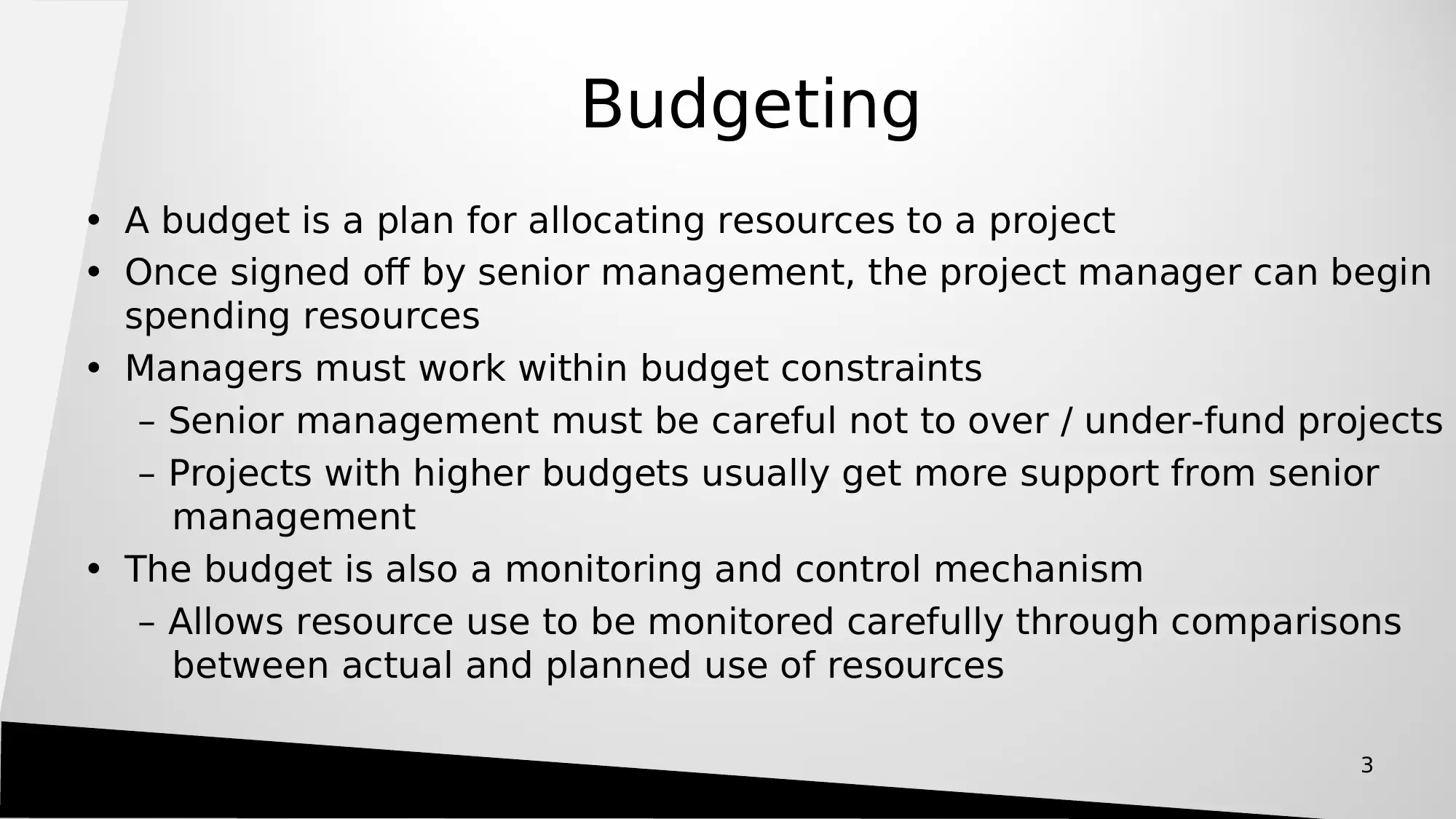
Budgeting
• A budget is a plan for allocating resources to a project
• Once signed off by senior management, the project manager can begin
spending resources
• Managers must work within budget constraints
– Senior management must be careful not to over / under-fund projects
– Projects with higher budgets usually get more support from senior
management
• The budget is also a monitoring and control mechanism
– Allows resource use to be monitored carefully through comparisons
between actual and planned use of resources
3
• A budget is a plan for allocating resources to a project
• Once signed off by senior management, the project manager can begin
spending resources
• Managers must work within budget constraints
– Senior management must be careful not to over / under-fund projects
– Projects with higher budgets usually get more support from senior
management
• The budget is also a monitoring and control mechanism
– Allows resource use to be monitored carefully through comparisons
between actual and planned use of resources
3
⊘ This is a preview!⊘
Do you want full access?
Subscribe today to unlock all pages.

Trusted by 1+ million students worldwide
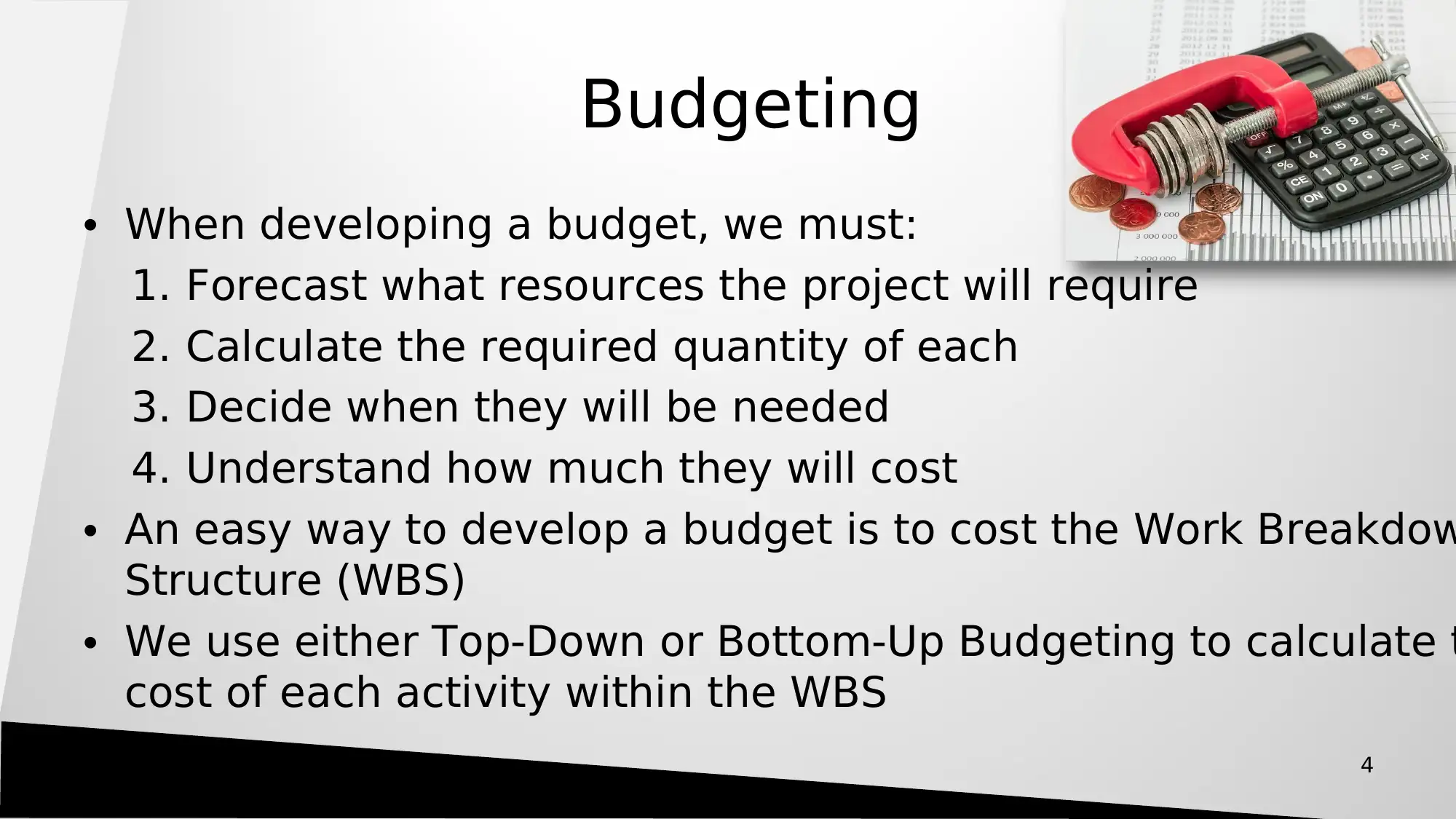
Budgeting
• When developing a budget, we must:
1. Forecast what resources the project will require
2. Calculate the required quantity of each
3. Decide when they will be needed
4. Understand how much they will cost
• An easy way to develop a budget is to cost the Work Breakdow
Structure (WBS)
• We use either Top-Down or Bottom-Up Budgeting to calculate t
cost of each activity within the WBS
4
• When developing a budget, we must:
1. Forecast what resources the project will require
2. Calculate the required quantity of each
3. Decide when they will be needed
4. Understand how much they will cost
• An easy way to develop a budget is to cost the Work Breakdow
Structure (WBS)
• We use either Top-Down or Bottom-Up Budgeting to calculate t
cost of each activity within the WBS
4
Paraphrase This Document
Need a fresh take? Get an instant paraphrase of this document with our AI Paraphraser
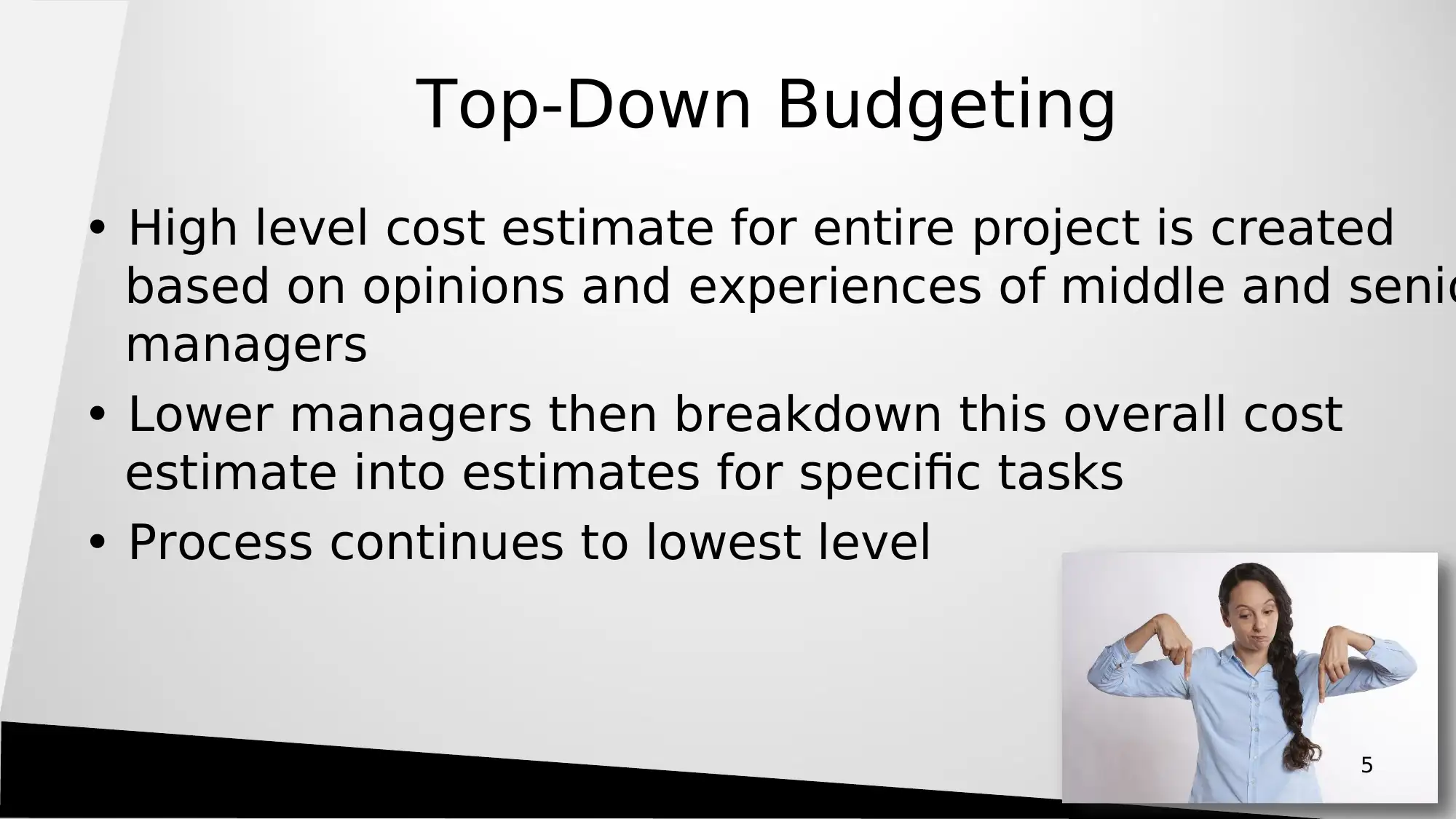
Top-Down Budgeting
• High level cost estimate for entire project is created
based on opinions and experiences of middle and senio
managers
• Lower managers then breakdown this overall cost
estimate into estimates for specific tasks
• Process continues to lowest level
5
• High level cost estimate for entire project is created
based on opinions and experiences of middle and senio
managers
• Lower managers then breakdown this overall cost
estimate into estimates for specific tasks
• Process continues to lowest level
5
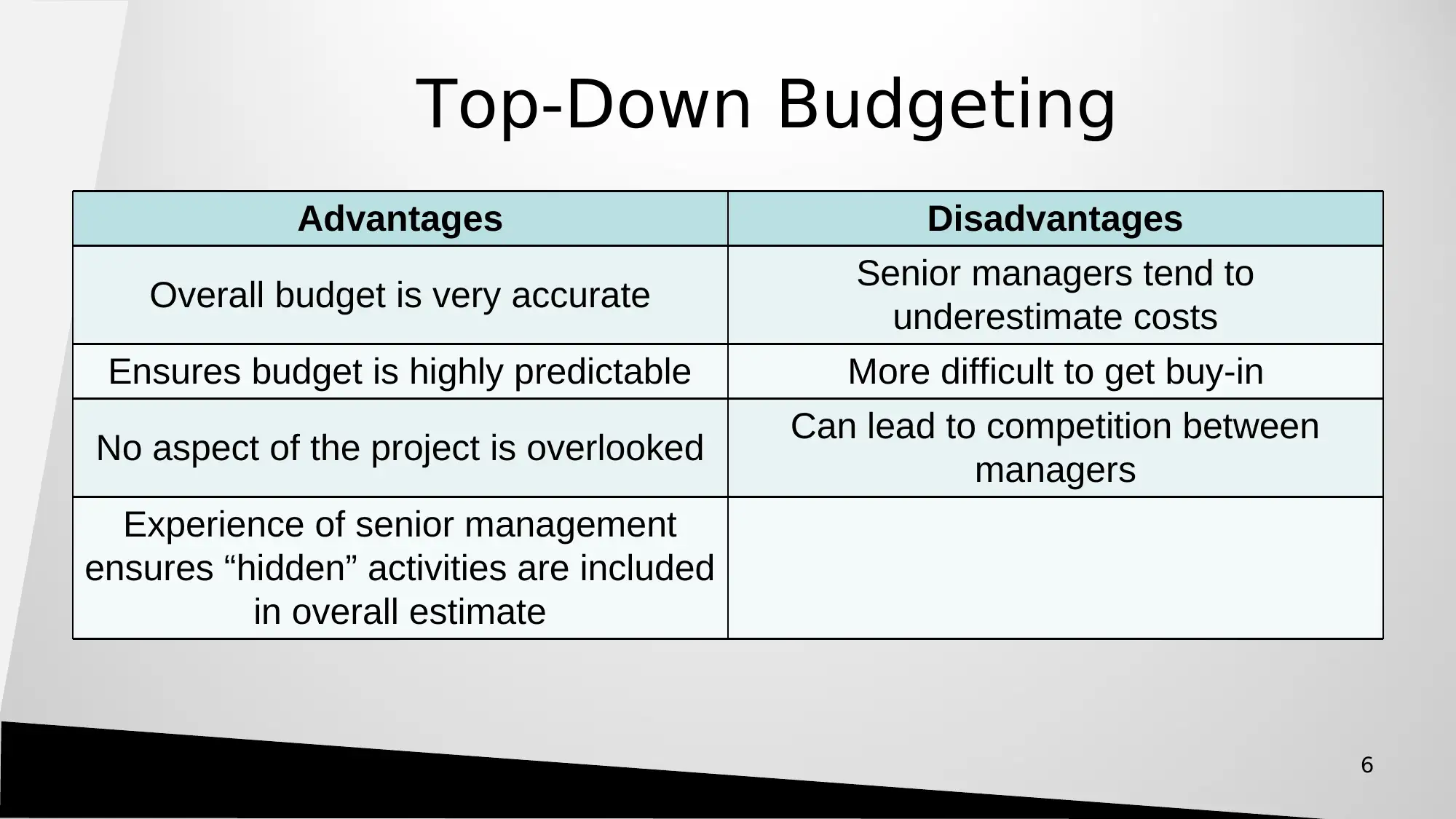
Top-Down Budgeting
Advantages Disadvantages
Overall budget is very accurate Senior managers tend to
underestimate costs
Ensures budget is highly predictable More difficult to get buy-in
No aspect of the project is overlooked Can lead to competition between
managers
Experience of senior management
ensures “hidden” activities are included
in overall estimate
6
Advantages Disadvantages
Overall budget is very accurate Senior managers tend to
underestimate costs
Ensures budget is highly predictable More difficult to get buy-in
No aspect of the project is overlooked Can lead to competition between
managers
Experience of senior management
ensures “hidden” activities are included
in overall estimate
6
⊘ This is a preview!⊘
Do you want full access?
Subscribe today to unlock all pages.

Trusted by 1+ million students worldwide
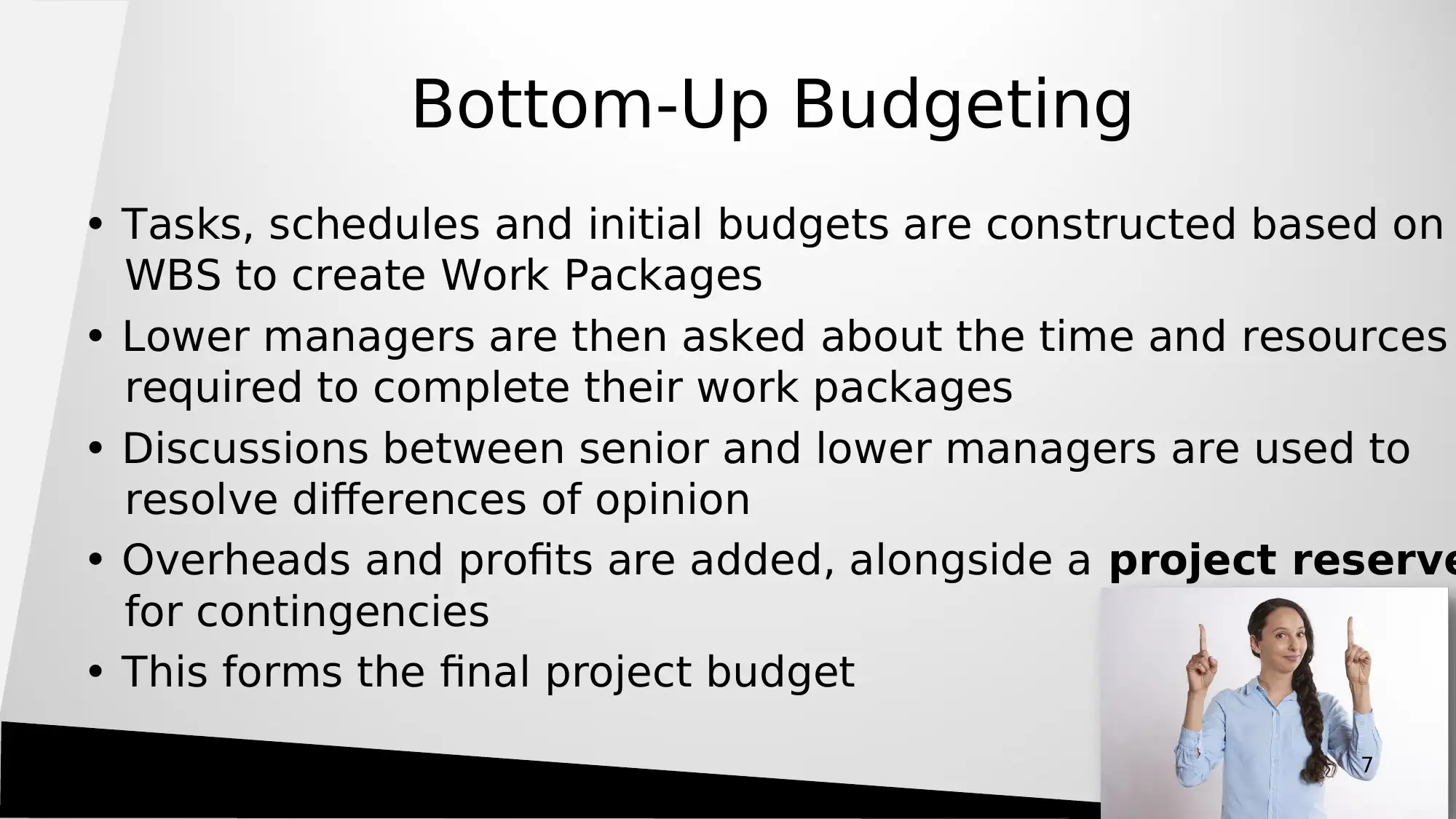
Bottom-Up Budgeting
• Tasks, schedules and initial budgets are constructed based on
WBS to create Work Packages
• Lower managers are then asked about the time and resources
required to complete their work packages
• Discussions between senior and lower managers are used to
resolve differences of opinion
• Overheads and profits are added, alongside a project reserve
for contingencies
• This forms the final project budget
7
• Tasks, schedules and initial budgets are constructed based on
WBS to create Work Packages
• Lower managers are then asked about the time and resources
required to complete their work packages
• Discussions between senior and lower managers are used to
resolve differences of opinion
• Overheads and profits are added, alongside a project reserve
for contingencies
• This forms the final project budget
7
Paraphrase This Document
Need a fresh take? Get an instant paraphrase of this document with our AI Paraphraser
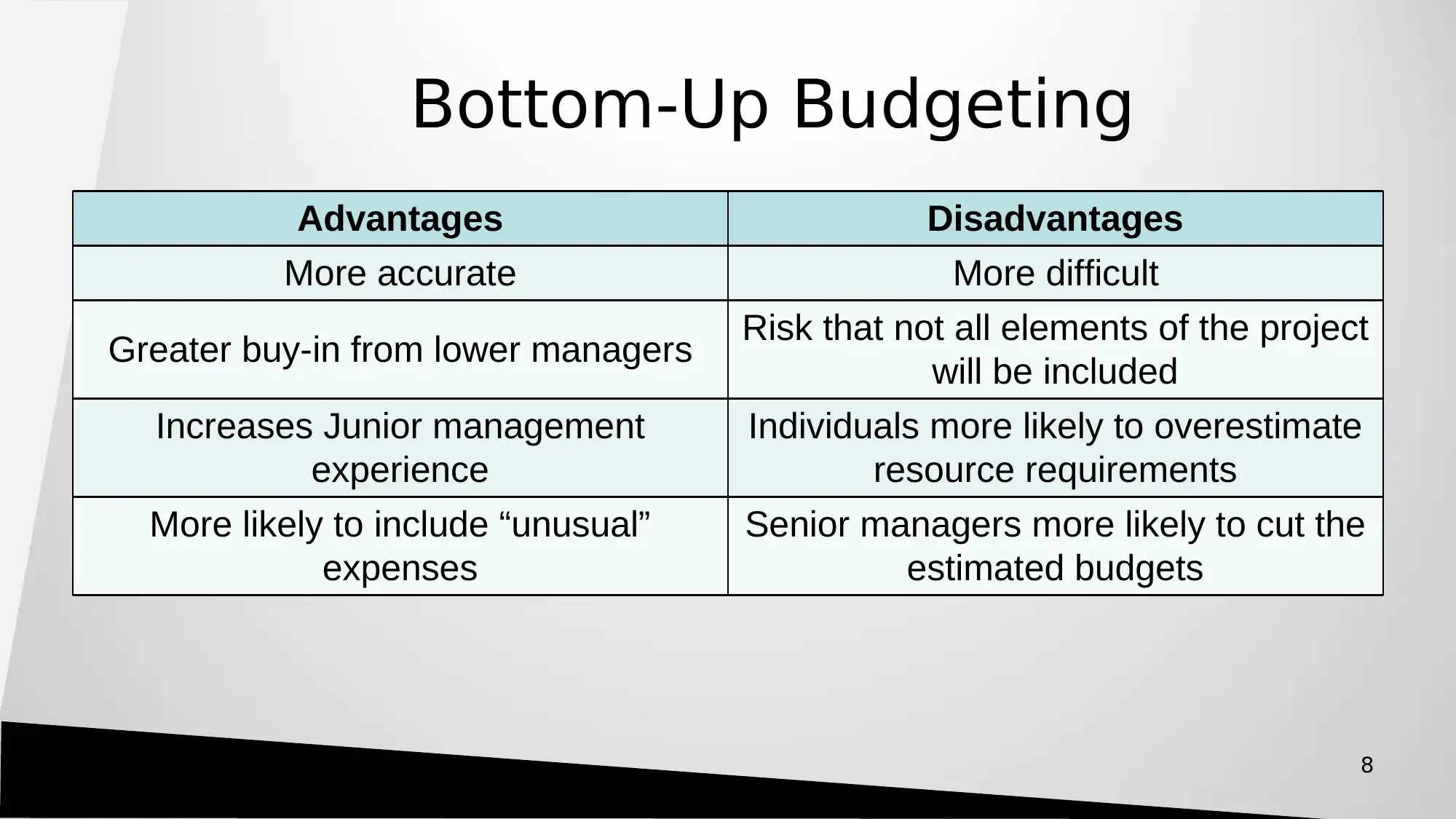
Bottom-Up Budgeting
Advantages Disadvantages
More accurate More difficult
Greater buy-in from lower managers Risk that not all elements of the project
will be included
Increases Junior management
experience
Individuals more likely to overestimate
resource requirements
More likely to include “unusual”
expenses
Senior managers more likely to cut the
estimated budgets
8
Advantages Disadvantages
More accurate More difficult
Greater buy-in from lower managers Risk that not all elements of the project
will be included
Increases Junior management
experience
Individuals more likely to overestimate
resource requirements
More likely to include “unusual”
expenses
Senior managers more likely to cut the
estimated budgets
8
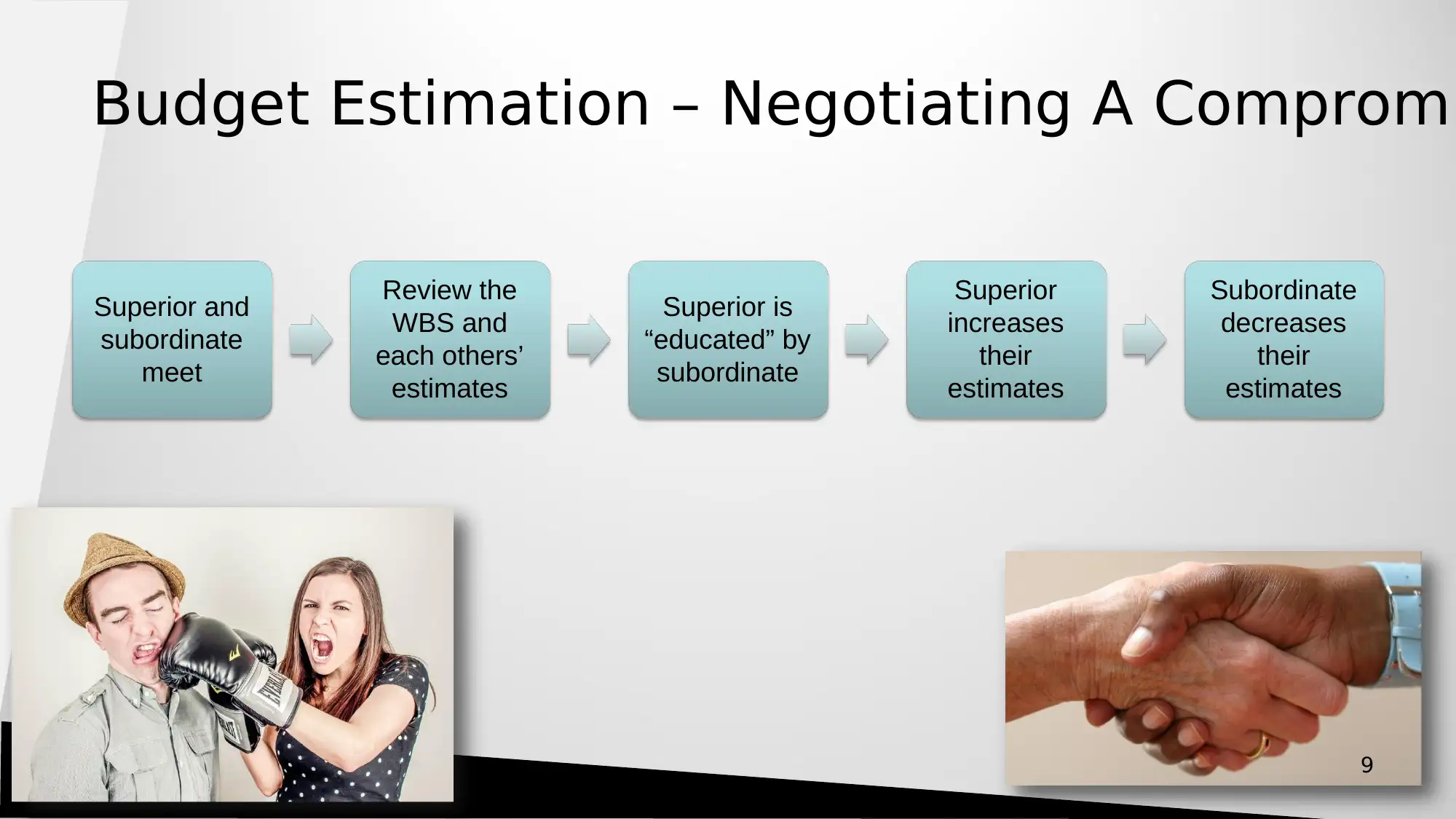
Budget Estimation – Negotiating A Compromi
Superior and
subordinate
meet
Review the
WBS and
each others’
estimates
Superior is
“educated” by
subordinate
Superior
increases
their
estimates
Subordinate
decreases
their
estimates
9
Superior and
subordinate
meet
Review the
WBS and
each others’
estimates
Superior is
“educated” by
subordinate
Superior
increases
their
estimates
Subordinate
decreases
their
estimates
9
⊘ This is a preview!⊘
Do you want full access?
Subscribe today to unlock all pages.

Trusted by 1+ million students worldwide
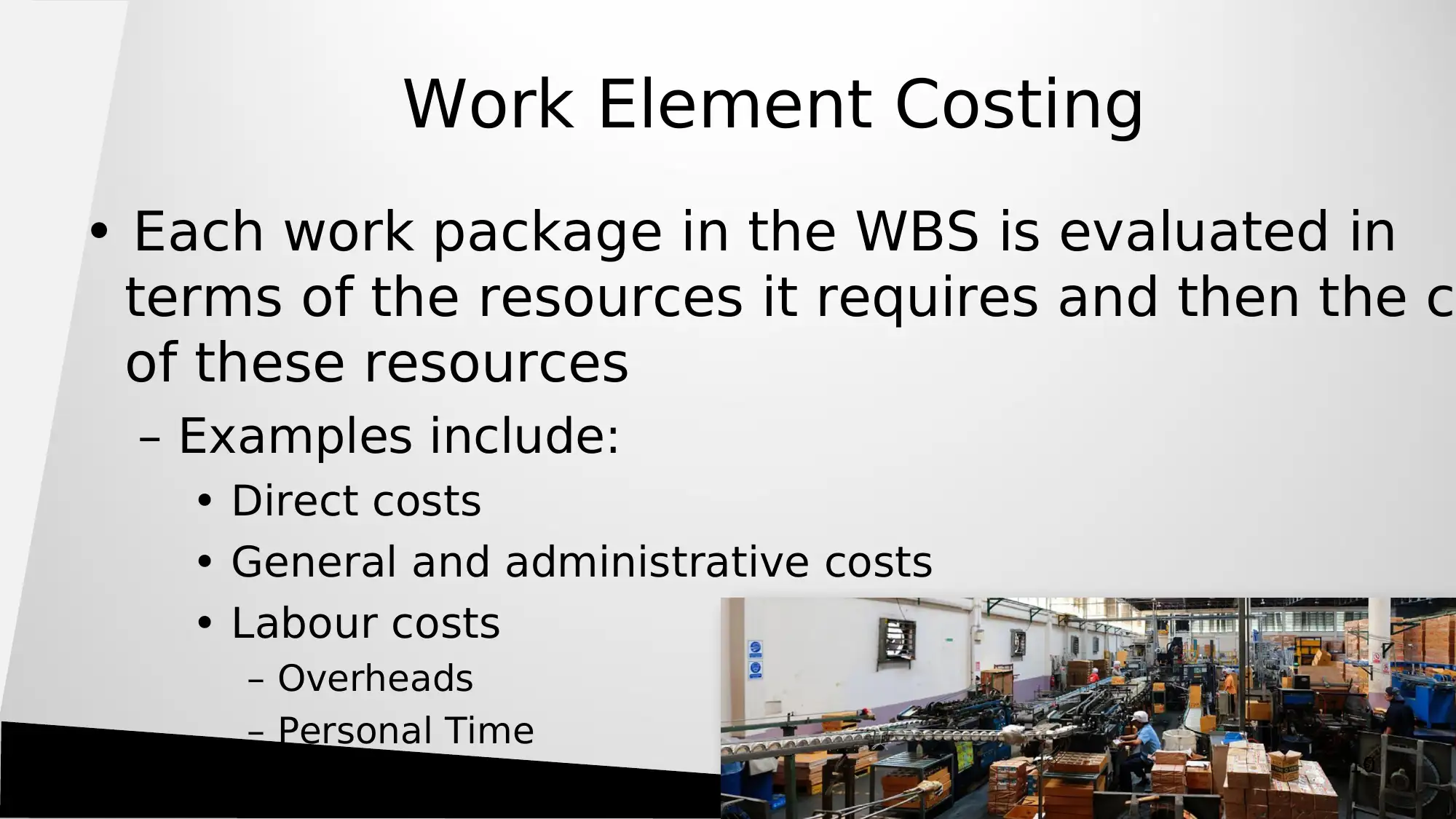
Work Element Costing
• Each work package in the WBS is evaluated in
terms of the resources it requires and then the co
of these resources
– Examples include:
• Direct costs
• General and administrative costs
• Labour costs
– Overheads
– Personal Time 10
• Each work package in the WBS is evaluated in
terms of the resources it requires and then the co
of these resources
– Examples include:
• Direct costs
• General and administrative costs
• Labour costs
– Overheads
– Personal Time 10
Paraphrase This Document
Need a fresh take? Get an instant paraphrase of this document with our AI Paraphraser
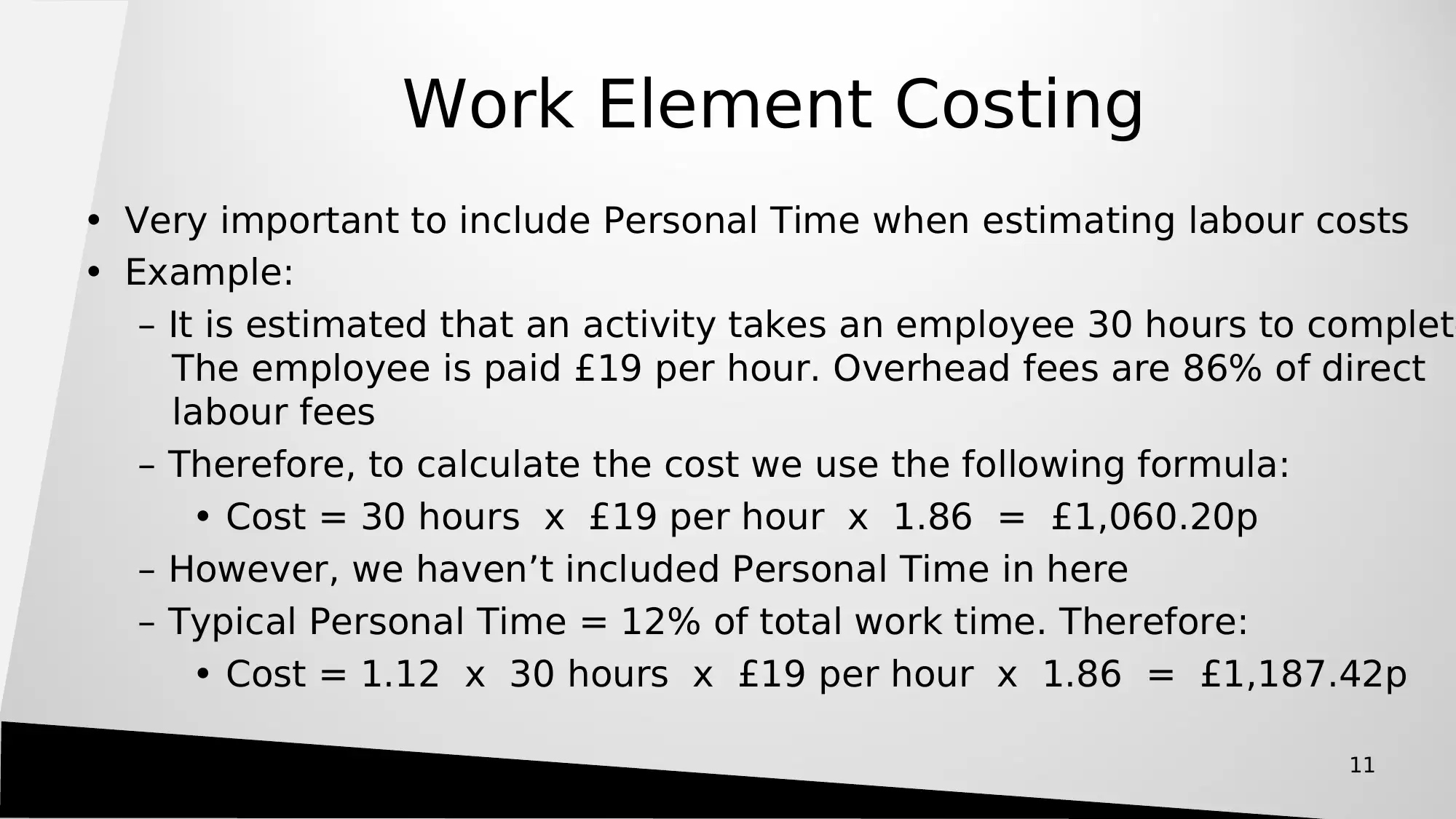
Work Element Costing
• Very important to include Personal Time when estimating labour costs
• Example:
– It is estimated that an activity takes an employee 30 hours to complete
The employee is paid £19 per hour. Overhead fees are 86% of direct
labour fees
– Therefore, to calculate the cost we use the following formula:
• Cost = 30 hours x £19 per hour x 1.86 = £1,060.20p
– However, we haven’t included Personal Time in here
– Typical Personal Time = 12% of total work time. Therefore:
• Cost = 1.12 x 30 hours x £19 per hour x 1.86 = £1,187.42p
11
• Very important to include Personal Time when estimating labour costs
• Example:
– It is estimated that an activity takes an employee 30 hours to complete
The employee is paid £19 per hour. Overhead fees are 86% of direct
labour fees
– Therefore, to calculate the cost we use the following formula:
• Cost = 30 hours x £19 per hour x 1.86 = £1,060.20p
– However, we haven’t included Personal Time in here
– Typical Personal Time = 12% of total work time. Therefore:
• Cost = 1.12 x 30 hours x £19 per hour x 1.86 = £1,187.42p
11
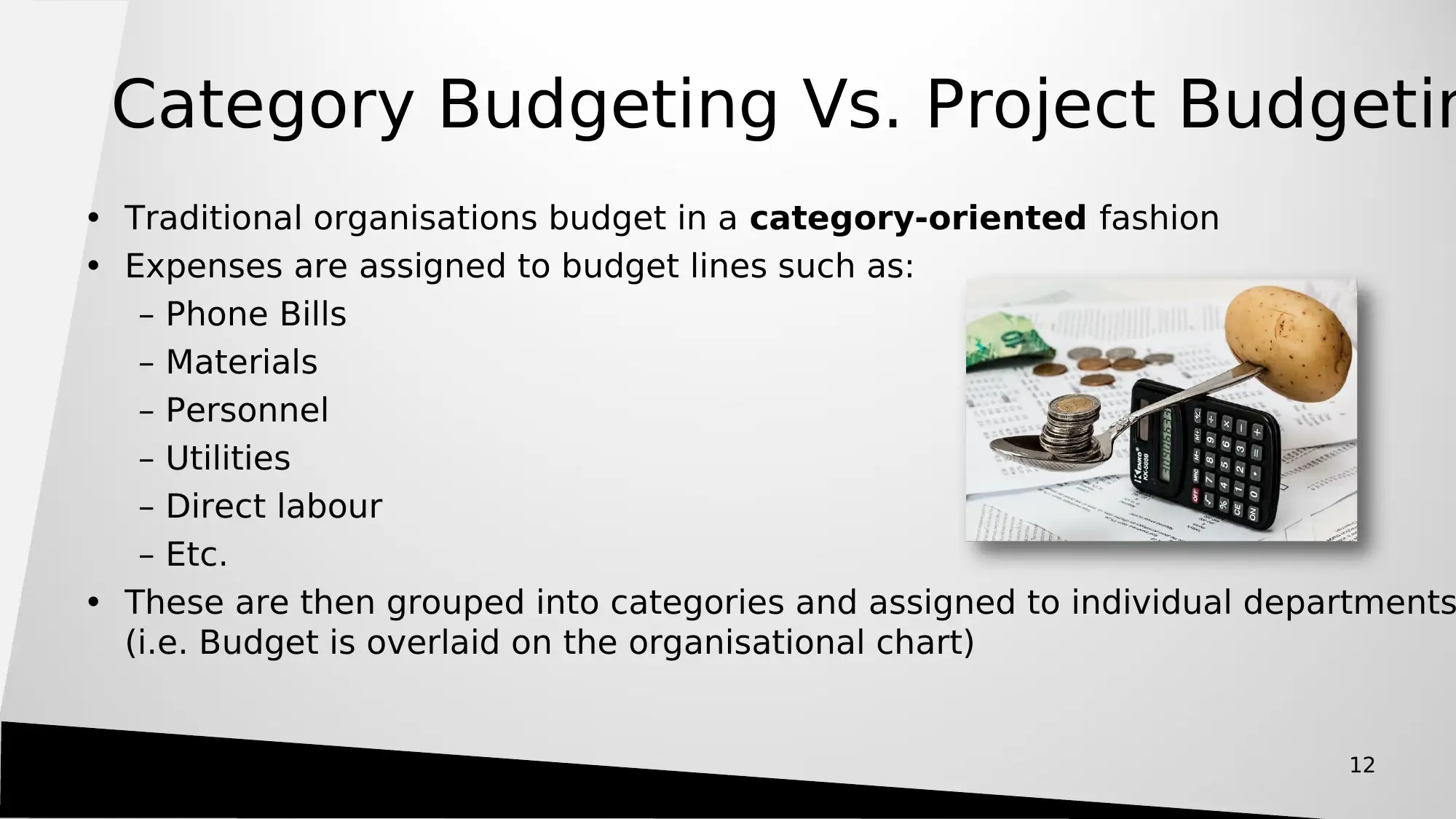
Category Budgeting Vs. Project Budgetin
• Traditional organisations budget in a category-oriented fashion
• Expenses are assigned to budget lines such as:
– Phone Bills
– Materials
– Personnel
– Utilities
– Direct labour
– Etc.
• These are then grouped into categories and assigned to individual departments
(i.e. Budget is overlaid on the organisational chart)
12
• Traditional organisations budget in a category-oriented fashion
• Expenses are assigned to budget lines such as:
– Phone Bills
– Materials
– Personnel
– Utilities
– Direct labour
– Etc.
• These are then grouped into categories and assigned to individual departments
(i.e. Budget is overlaid on the organisational chart)
12
⊘ This is a preview!⊘
Do you want full access?
Subscribe today to unlock all pages.

Trusted by 1+ million students worldwide
1 out of 44
Related Documents
Your All-in-One AI-Powered Toolkit for Academic Success.
+13062052269
info@desklib.com
Available 24*7 on WhatsApp / Email
![[object Object]](/_next/static/media/star-bottom.7253800d.svg)
Unlock your academic potential
Copyright © 2020–2025 A2Z Services. All Rights Reserved. Developed and managed by ZUCOL.




